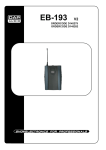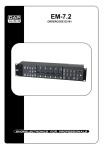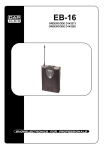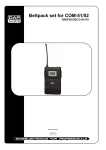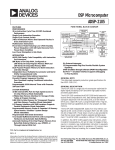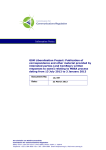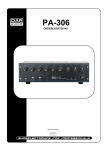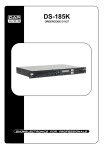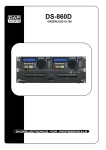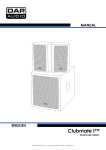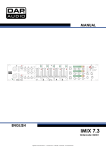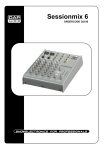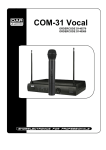Download IEM-100
Transcript
IEM-100 ORDERCODE D147079 D147082 Congratulations! You have bought a great, innovative product from DAP Audio. The DAP Audio IEM-100 brings excitement to any venue. You can rely on DAP Audio, for more excellent audio products. We design and manufacture professional audio equipment for the entertainment industry. New products are being launched regularly. We work hard to keep you, our customer, satisfied. For more information: [email protected] You can get some of the best quality, best priced products on the market from DAP Audio. So next time, turn to DAP Audio for more great audio equipment. Always get the best -- with DAP Audio ! Thank you! DAP Audio DAP Audio IEM-100™ Product Guide Warning................................................................................................................................................................... Safety-instructions............................................................................................................................................. Operating Determinations............................................................................................................................... 2 2 3 Description.............................................................................................................................................................. Features.............................................................................................................................................................. Overview............................................................................................................................................................ Frontside............................................................................................................................................................. Backside............................................................................................................................................................. Transmitter.......................................................................................................................................................... 4 4 4 4 5 5 Installation............................................................................................................................................................... 6 Set Up and Operation............................................................................................................................................ Set Up................................................................................................................................................................. Inserting/replacing the battery....................................................................................................................... Adjusting the squelch threshold...................................................................................................................... Tips for achieving maximum performance.................................................................................................... 6 6 9 11 11 Frequency ranges.................................................................................................................................................. 11 Declaration of conformity..................................................................................................................................... 12 Connection Cables..............................….......................................………..………….…….………….…............... 14 Maintenance………..............................….......................................………..………….…….………….…............... 15 Troubleshooting………..............................…................................………..………….…….………….….................. 15 Product Specifications.................................................................……………….…….………………….................. 16 1 WARNING CAUTION! Keep this device away from rain and moisture! FOR YOUR OWN SAFETY, PLEASE READ THIS USER MANUAL CAREFULLY BEFORE YOUR INITIAL START-UP! SAFETY INSTRUCTIONS Every person involved with the installation, operation and maintenance of this device has to: be qualified follow the instructions of this manual CAUTION! Be careful with your operations. With a dangerous voltage you can suffer a dangerous electric shock when touching the wires! Before your initial start-up, please make sure that there is no damage caused by transportation. Should there be any, consult your dealer and do not use the device. To maintain perfect condition and to ensure a safe operation, it is absolutely necessary for the user to follow the safety instructions and warning notes written in this manual. Please consider that damages caused by manual modifications to the device are not subject to warranty. This device contains no user-serviceable parts. Refer servicing to qualified technicians only. IMPORTANT: The manufacturer will not accept liability for any resulting damages caused by the nonobservance of this manual or any unauthorized modification to the device. Never let the power-cord come into contact with other cables! Handle the power-cord and all connections with the mains with particular caution! Never remove warning or informative labels from the unit. Never use anything to cover the ground contact. Never leave any cables lying around. Do not open the device and do not modify the device. Do not insert objects into air vents. Do not connect this device to a dimmerpack. Do not switch the system on and off in short intervals, as this would reduce the system’s life. Do not drive the inputs with a signal level bigger, than required to drive the equipment to full output. Do not plug Mics into the console (or stagebox) while Phantom Power is on. Also mute the monitor / Pa system when turning Phantom Power on or off. Allow the system to adjust for a couple of seconds, before setting the input gains. Only use device indoor, avoid contact with water or other liquids. Avoid flames and do not put close to flammable liquids or gases. Always disconnect power from the mains, when device is not used or before cleaning! Only handle the power-cord by the plug. Never pull out the plug by tugging the power-cord. Always operate the unit with the AC ground wire connected to the electrical system ground. Make sure you don’t use the wrong kind of cables or defective cables. Make sure that the signals into the mixer are balanced, otherwise hum could be created. Make sure you use DI boxes to balance unbalanced signals; All incoming signals should be clear. 2 Make sure that the available voltage is not higher than stated on the rear panel. Make sure that the power-cord is never crimped or damaged. Check the system and the powercord from time to time. In system setup, the amplifier's output power must be 50%-100% more than the loaded loudspeakers rated power. Please turn off the power switch, when changing the power cord or signal cable, or select the input mode switch. Extreme frequency boosts in connection with a high input signal level may lead to overdriving your equipment. Should this occur, it is necessary to reduce the input signal level by using the INPUT control. To emphasize a frequency range, you don’t necessarily have to move its respective sliding control upward; try lowering surrounding frequency ranges instead. This way, you avoid causing the next piece of equipment in your sound path to overdrive. You also preserve valuable dynamic reserve (“headroom”) Avoid ground loops! Always be sure to connect the power amps and the mixing console to the same electrical circuit to ensure the same phase! If system is dropped or struck, disconnect mains power supply immediately. Have a qualified engineer inspect for safety before operating. If the system has been exposed to drastic temperature fluctuation (e.g. after transportation), do not switch it on immediately. The arising condensation water might damage your system. Leave the system switched off until it has reached room temperature. If your Dap Audio device fails to work properly, discontinue use immediately. Pack the unit securely (preferably in the original packing material), and return it to your Dap Audio dealer for service. Repairs, servicing and electric connection must be carried out by a qualified technician. For replacement use fuses of same type and rating only. WARRANTY: Till one year after date of purchase. OPERATING DETERMINATIONS This device is not designed for permanent operation. Consistent operation breaks will ensure that the device will serve you for a long time without defects. If this device is operated in any other way, than the one described in this manual, the product may suffer damages and the warranty becomes void. Any other operation may lead to dangers like short-circuit, burns, electric shock, lamp explosion, crash etc. You endanger your own safety and the safety of others! Improper installation can cause serious damage to people and property ! 3 Description of the device Features The IEM-100 is a Wireless In Ear Monitor Set from Dap Audio. • UHF-band PLL Synthesized design. • Frequency agility over a 25MHz bandwith, with 48 pre-programmed frequencies avaiable. • Built-in limiter circuitry eliminates distortion under excessive input levels. • Front panel monitoring headphone jack • Dual-antenna true diversity receiver, eliminating signal dropout and enhancing RF stability. Overview Fig. 1 1. Power switch Turns transmitter on or off. 2. Headphone out jack To connect a monitoring headphone. 3. Headphone volume control Used to adjust the headphone volume level. 4. Limit indicator L Lights if the incoming signal (Left/ channel 1)exceeds the limiting threshold. 5. Display 6. Limit indicator R Lights if the incoming signal (Right/ channel 2)exceeds the limiting threshold. 7. Menu button 8. Up button 9. Set button 10. Down button Fig. 2 11. 12. 13. 14. Antenna XLR balanced Audio Out connector ¼” Phone jack audio Input connector (Unbalanced High Z). Gain Switch Used to set the input sensitivity. 15. Power input connector. Please use the supplied AC adapter only. 4 Fig. 3 1. 2. 3. 4. 5. 6. 7. 8. 9. 10. 11. Left Antenna/ Squelch indicator Display Antenna’s Power on/off and volume control Balance control Right Antenna/ Squelch indicator Set button Up button Down button Belt clip Headphone jack 5 Installation Remove all packing materials from the IEM-100. Check that all foam and plastic padding is removed. Always disconnect from electric mains power supply before cleaning or servicing. Damages caused by non-observance are not subject to warranty. Set Up and Operation Before plugging the unit in, always make sure that the power supply matches the product specification voltage. Do not attempt to operate a 120V specification product on 230V power, or vice versa. Transmitter Control Fig. 3 1. 2. 3. 4. 5. 6. Level audio left/ channel 1 Level audio right/ channel 2 Transmission power Limiter on/ off Channel Frequency Frequency setting: Press the SET button to enter the setting state. Now press the MENU button until the display of frequency/channel is flashing (see Figure 4). Use the up/down buttons to set the proper frequency. Fig. 4 Volume limiter setting: Press the SET button to enter the seting state. Hold down the MENU button until the Limit indicator is flashing (see Figure 5). Now use the up / down button to switch the limiter on or off. Indicates that the limiter function is switched in. Indicates that the limiter function is switched off. Fig. 5 6 Transmission power setting: Press the SET button to enter the seting state. Hold down the MENU button until the transmission power indicator is flashing (see Figure 6). Use the up/down buttons to adjust the transmission power. Fig. 6 Note: If no button is pressed for 3 seconds, the system will automaticly exit the setting state and save the current setting. Transmitter Functions Limiter function: If the limiter is switched on, the volume will automatically be decreased if the value rises above the set threshold. This in order to avoid distortion and protect your ears. Power: RF-power 10dBM (10mW) RF-power 15dBM (31,62mW) RF-power 20dBM (100mW) Gain control of input level: Set the switch in the +10dB position for low output equipement. Receiver control Audio Left/ Right Control. Rotate the Audio Control knob for adjusting the balance between Audio Left/ Right or Channel 1/2. In Mid position the Audio Left and Right are set to the same volume level. Fig. 7 ON/OFF/VOLUME Control. Rotate the ON/OFF/VOLUME knob to adjust the volume. Frequency/ Channel Setting. 7 Press the up or down button until the Frequency/ Channel starts flashing, you’re now in the setting state. a.Press the SET button to switch between Frequency and Channel. b.Use the up/down buttons to set the desired Frequency/ Channel. Fig. 8 Receiver Setting Press the SET button to switch between MIX, LIM, SQL and EQ. MIX/ Stereo Output Setting: Use the SET button until MIX is flashing( see Figure 9). Use the Up or Down button to switch the MIX function on or off. Means MIX mode is selected. Means STEREO Mode is selected. Volume Limiter Setting: Press the SET button until LIM is flashing (Figure 10). Means LIM mode is switched in. Means LIM Mode is switched off. Fig. 10 8 Squelch Setting: Press the SET button until SQL is flashing (Figure 11). Use the up/ down button to adjust the squelch setting. Fig. 11 Equalizer Setting: Press the SET button until EQ is flashing (Figure 12). Use the Up or Down button to adjust the Audio Balance. Fig. 12 Note: If no button is pressed for 3 seconds, the system will automaticly exit the setting state and save the current setting. Receiver Battery Installation Fig. 13 Press the battery compartment door And slide the cover in the direction As shown in Figure 13. Install the batteries. 9 Receiver Functions 1. Limiter function; If the limiter is switched on, the volume will corrected automatically if the value rises above the set threshold. This in order to avoid distortion and protect your ears. 2. Equalizer setting: Treble boost 6dB Bass boost 6dB Bass + treble boost 6dB flat 3. Squelch setting: If the RF signal is less then the squelch setting. The signal indicator will dim and the audio output will be muted. Mix Mode/ Stereo Control The receiver receives two signals (1/L and 2/R) from the transmitter and then processes these signals in either mix or stero mode. Stereo Mode In stereo mode the signals remain separate so that 1/L is heard through the left headphone and 2/R is heard through the right headphone. The balance knob on the receiver can be used to adjust the balance between the left and right headphones. See Figure 14. Fig. 14 Mix Mode In Mix mode the 1/L and 2/R signals are mixed into a mono signal using the balance knob. The mono signal is sent to headphone L and headphone R. See Figure 15. Fig. 15 Mono Mode Used when only one (mono) monitor mix is available. 10 Adjusting the squelch threshold. Interference due to other transmission links can be eliminated as follows: Switch off the transmitter. The receiver should no longer receive a signal. If the receiver still receives a signal, increase the squelch threshold so that the signal will no longer be received. If the signal cannot be eliminated in this way, set the transmitter and the receiver to a different channel. Switch on the transmitter again and check if the receiver receives the transmitter signal. Note: If the squelch threshold is adjusted to high, the transmission range will be reduced. Therefore always adjust the squelch control to the lowest possible setting. Tips for achieving maximum performance. Make sure you can always see a receiver antenna from the transmitter position. Keep the distance from transmitter to receiver antenna as short as possible. Point the receiver antennas away from each other at 45 degrees angle from vertical position. Avoid placing the receiver antennas near metal surfaces and obstructions. Replace battery as soon as low battery LED lights. If stacking or rack mounting receivers in a multiple system setup. Do not allow antennas to cross. Perform a walk-through before performance or presentation. If dead spots are found, adjust the location of the receiver. If dead spots remain, mark the dead spots and avoid them. IEM-100 frequencies IEM-100. D147079: 785-811 MHz for use in: D147082: 822-846 Mhz for use in: Australia, Brasil, Canada, Czech Republic, China/ Hong Kong, Denmark, Egypt, France, Germany, Greece, Hungary, Iran, Israel, Italy, Japan, Luxemburg, Netherlands, Norway, Poland, Portugal, Romania, Slovakia, Sweden, Switzerland, Turkey, United Kingdom, USA. Czech Republic, China/ Hong Kong. France, Germany, Hungary, Iran, Italy, Luxemburg, Netherlands, Poland, Romania, Switzerland, United Kingdom. Please check: DAP Audio Wireless Systems Frequency Table for more details. 11 Connection Cables Take care of the connector cables, always holding them by the connectors and avoiding knots and twists when coiling them: This gives the advantage of increasing their life and reliability, which is always to your advantage. Periodically check that your cables are in good condition, that they are correctly wired and that all their contacts are perfectly efficient: a great number of problems (faulty contacts, ground hum, discharges, etc.) are caused entirely by using unsuitable or faulty cables. Headphones plug Unbalanced mono 1/4” jack plug Balanced mono 1/4” jack Compensation of interference with balanced connections 14 Maintenance The DAP Audio IEM-100 requires almost no maintenance. However, you should keep the unit clean. Disconnect the mains power supply, and then wipe the cover with a damp cloth. Do not immerse in liquid. Do not use alcohol or solvents. Keep connections clean. Disconnect electric power, and then wipe the Antenna and audio connections with a damp cloth. Make sure connections are thoroughly dry before linking equipment or supplying electric power. Troubleshooting DAP Audio IEM-100 This troubleshooting guide is meant to help solve simple problems. If a problem occurs, carry out the steps below in sequence until a solution is found. Once the unit operates properly, do not carry out following steps. 1. If the device does not operate properly, unplug the device. 2. Check power from the wall, all cables, the fuse, etc. 3. If all of the above appears to be O.K., plug the unit in again. 4. If nothing happens after 30 seconds, unplug the device. 5. Return the device to your DAP Audio dealer. 15 Product Specification Model: DAP Audio IEM-100 Receiver Frequency range: 720 – 865 MHz Bandwidth: 25MHz Max. deviation range: 68kHz S/N Ratio: 94dB Sensitivity: -107dBM T.H.D.: <1% Headphone impedance: 16Ω Headphone output level: 2 x 50mW Frequency response: 80-15.000Hz Stereo separation: 35dB Output Jack: 3.5mm stereo jack Power supply: 2AA batteries Current consumption: 150mA Dimensions: 123 x 65 x 27mm (LxWxH) Transmitter Dynamic range: >100dB Frequency range: 785-811MHz and 822-846MHz Bandwidth: 25MHz Max. deviation range: 25kHz Spurious emission: >60dB RF-output: 10mW/ 100mW (low/ high) Frequency response: 50-15.000Hz THD: <0.5 Audio output: XLR Line level x 2 Audio input: 6.3mm phone jack x 2 Headphone output: 6.3mm stereo headphone jack Headphone output impedance: 16Ω Power supply: 12-14V DC Dimensions: 210 x 175 x 45mm (LxWxH) Design and product specifications are subject to change without prior notice. Website: www.Highlite.nl Email: [email protected] 16 2008 Dap Audio.



















